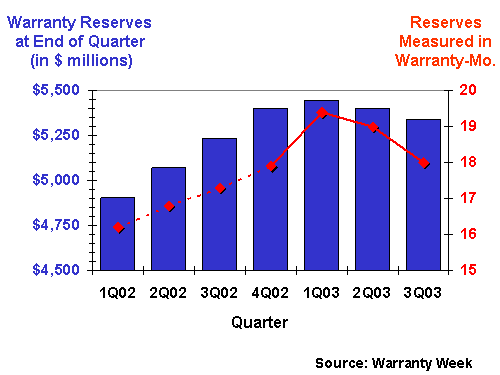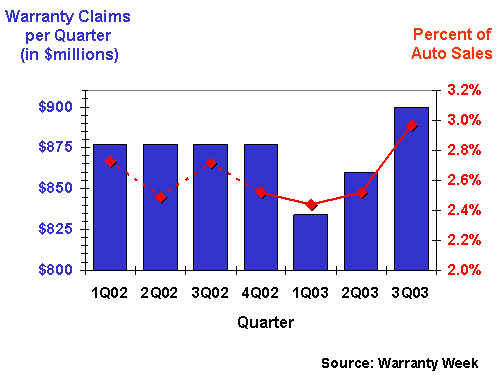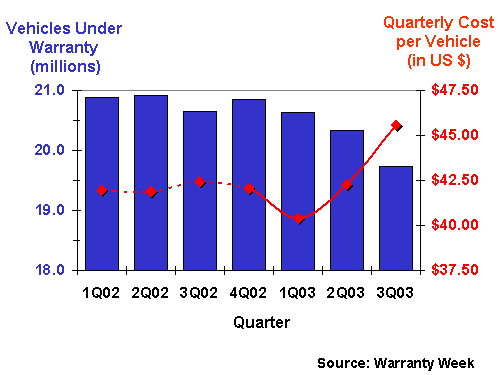November 17, 2003 |
ISSN 1550-9214 |
Ford's Warranty Reserves:Standard & Poor's cut Ford Motor Company's credit rating from BBB to BBB-, citing write-offs at Ford Europe, reduced warranty accruals, and lowered reserves for bad loans by Ford Credit. But were those reduced warranty accruals justified by reduced claims costs?
In something of a replay of the criticisms leveled at General Motors Corp. over the summer when analysts said withdrawals from its warranty reserve fund lowered the quality of its earnings, S&P credit analyst Scott Sprinzen pointed out that the slim $53 million net profit posted by Ford's automotive sector for the first nine months of 2003 would have been a net loss were it not for the $268 million removed from the warranty reserve fund through a downward change in estimate for pre-existing warranties. This was only half the story, however. In 2002, following a huge unplanned $2 billion expenditure addressing safety problems alleged for Firestone tires and the Ford Explorer, the company added $595 million to its reserve fund through an upward change in estimate for pre-existing warranties. Without that extra expense, Ford's 2002 net loss of $987 million would have been much smaller. The real story here is that warranty accounting is now more transparent, and its effects on the bottom line more understood than ever before. These warranty changes of estimate, which a year ago barely made an appearance on the typical company's balance sheet or income statement, are now part of the financial statements in the public domain. Ford has now made four detailed warranty disclosures: one covering all of 2002, and then one covering each of the first, second, and third quarters of 2003. Ford covers most of its vehicles with a three-year, 36,000-mile warranty, although some of the luxury models have four-year warranties and most of the European models are covered by two-year warranties. By matching the warranty data to Ford's vehicle production data, Warranty Week has found some metrics that support the company's decision to remove funds from its warranty reserve, and some that would seem to counsel against their removal. A year ago, though, none of this analysis would have been possible, because at that time warranty disclosures were occasional and brief. The S&P Version of EventsS&P announced on Oct. 21 that it planned to review Ford's BBB credit rating, after lowering DaimlerChrysler AG to a BBB with a negative outlook. Ford is now assigned a BBB- with a stable outlook, meaning that further downgrades are not anticipated. GM remains at a BBB with a negative outlook, meaning that S&P sees a possibility of downgrades ahead. Both GM and DC are likely to keep their current ratings, Sprinzen said, although he sees the outlook as more negative for GM. He sees Chrysler's U.S. situation as weaker than either GM's or Ford's, but Daimler's worldwide car and truck operations are a counterweight to that weakness. However, he said he's comfortable with the current situation where GM has a slightly better rating than Ford, because for instance, GM's market share hasn't fallen as much as Ford's, and GM Europe's problems seem more manageable to him than Ford Europe's. S&P's outlook is stable for Ford, Sprinzen added, for at least two years. Earnings and cash flow should improve in 2004 and 2005, as Ford benefits from an upswing in the business cycle. "But even if the improvement doesn't materialize, we could well still be OK with the [BBB-] rating as long as there isn't significant deterioration," Sprinzen said. "Today, looking out over the next two years, we don't see a significant possibility of a further downgrade. But if need be, we'll reassess that." S&P opened its review of Ford's credit rating after the automaker detailed its initial third quarter earnings report during an Oct. 16 conference call but before Ford filed its comprehensive Form 10-Q with the U.S. Securities and Exchange Commission. During that initial announcement, Ford reported an overall company-wide net loss of $25 million, or 1 cent per share, balancing out the effects of a net loss of $609 million in its automotive sector, net income of $504 million at Ford Credit, and a $56 million restructuring charge at Ford Europe, among other factors. At that time, Ford cited gains in vehicle quality and reductions in product recalls as a factor in its decision to continue removing funds from its warranty reserves. But it wasn't until the 10-Q was filed on Nov. 13 -- the day after the S&P downgrade -- that Ford publicly revealed it removed $132 million from the reserve fund in the third quarter, following removals of $113 million in the second quarter and $23 million in the first quarter. Sprinzen said these withdrawals were a factor in the downgrade, which he hastened to add are voted upon by a committee. "As we analyzed matters further in the course of this review, we concluded that from our analytics perspective, earnings performance was weaker than the breakeven result would seem to suggest," he said during a Nov. 12 conference call. "For one thing, as Ford pointed out in its third quarter earnings conference call, there have been changes to accruals related to pre-existing warranties. There certainly has been substantial progress at Ford in the area of product quality, and that's been reflected in their warranty and recall experience. But we believe the year-to-year benefit of that is magnified on the income statement, just given the way the accounting works." The accounting for these downward revisions removes funds from the warranty reserve and adds them to net income (before taxes). That makes net income seem higher than it otherwise would, and makes year-ago comparisons look better. That, to Sprinzen, is a separate issue from whether or not the downwards revisions of estimate for pre-existing warranties were justified by changes in actual experience. "The underlying phenomenon here is certainly a big positive," Sprinzen said during the teleconference. "As I said, Ford has realized a significant improvement in their actual warranty and recall experience. All we're saying is the way that gets reflected on their income statement, it exaggerates the benefit as you're comparing '03 to '02." Sprinzen said he also was concerned by changes in accruals over at Ford Credit, specifically a significant decline in loan loss provisions despite a steady stream of charge-offs. The other major reason cited by Sprinzen for the downgrade was Ford Europe's slim chances of turning a meaningful profit in the near term even after recent restructurings, and the risk of additional restructuring charges in the future. He sees strengthening in Ford's Premier Automotive Group, more benefits from continued cost-cutting, and less pricing pressure on Ford in the U.S. auto market, but on balance, the company's auto business in 2003, "wasn't really any better than in 2002." During the question and answer segment of the conference call, Solomon Samson, a corporate credit analyst at S&P, said that regarding the downward adjustments of estimates for pre-existing warranties, "there's clearly the inter-relationship between the cash outlays and the desired reserve levels, and the accruals that are taken by a company in order to achieve the reserve levels." "It is difficult for someone to say categorically that one adjustment versus another adjustment is the only way to do things. So no matter what the disclosure might be about the details, we would be loath to light upon one particular number and say 'this is the number that deserves an analytical adjustment.'" He said Ford needs to make more disclosures about the reasons behind the adjustments it has made. Standard and Poor's Ratings Services is providing a replay of the whole teleconference at +1 (402) 220-4714 until Nov. 18 and a RealAudio replay on the company's Web site until Dec. 10 (follow the link, top right, for "Events"). Ford Motor's RebuttalRoughly an hour after the conclusion of S&P's conference call, Ford delivered its rebuttal of the credit rating service's findings in its own hour-long conference call. Don Leclair, Ford's chief financial officer, said he had a "high regard" for S&P's analytical abilities. "However, in this instance we do not agree with S&P's action to lower our credit rating," he added. He said more restructuring charges are planned at Ford Europe, but in general, the company's two-year-old plan to cut costs and boost revenue is on track. The reductions in accruals for pre-existing warranties are more than justified by actual experience, he said, because quality has improved, recalls are down, and warranty costs have decreased. "Our product quality continues to improve," Leclair said. "In particular, our recalls are down significantly -- over 60% reduction from 2000. This improvement in our vehicle quality is corroborated by J.D. Powers, and the recent Consumer Reports showed that we had 18 recommended buys. It also reflects ongoing improvements in the last several years in our dealer-reported warranty repairs per vehicle. Our costs have been going down, and we expect them to continue going down forward. We did indicate on our third quarter earnings call that the rate of improvement was unlikely to continue -- that's for the second half of this year compared with the first half of this year, and going forward into next year." The problem, he said, is recalls are down so far that there's not that much left to save on a year-over-year basis. But the accounting for warranty accruals and potential recalls is more automatic than it is discretionary, he said, so further changes are possible. "We have a very mechanical -- almost a cookbook approach -- to accruing for warranty and recalls," Leclair stated. "It is appropriate. It reflects improvements in our quality on a lag basis. Our external audit firm reviews our reserves regularly, and supports our approach." Leclair was later asked if there were any specific metrics he could share that supported those claims. "It is true that we have had less expense this year for quality, that is to say, current model coverages and recalls. The reason is that our quality is getting better. And that's measured in any number of ways. Our dealers are telling us, based on what they get from customers, that our warranty repairs per vehicle are down for several of the most recent model years. The number of recalls is down by over half over the past two years," he said. "Our expenses are down, therefore the reserves are changed in accordance with that, and our profits have improved on that basis," Leclair continued. "Out of the $3 billion in year-over-year cost performance this year, $1.6 billion is related to that. Of that, about half is related to recalls, and about half is related to prior model [warranty] coverages." A streaming audio replay of the Ford teleconference is available in both a RealAudio and a Windows Media format. Warranty Data AnalysisInternally, Ford produces reams of data to support the decisions it makes to add or remove funds from its warranty reserves. We wish it was all public information, and that Ford said exactly how much was spent per vehicle on warranty claims in each of the last several model years. But under FASB Interpretation No. 45, all that's expected of a manufacturer is the disclosure of an aggregate amount for warranty claims paid minus supplier recoveries, an aggregate amount for funds added to cover newly-issued warranties, an aggregate for changes of estimate made for pre-existing warranties, and of course the beginning and ending balances for the reserve fund. As mentioned earlier, Ford added $595 million last year and has subtracted $268 million so far this year to reflect its changing estimates of future costs for pre-existing warranties. As was detailed in an Aug. 18 article about General Motors' own warranty accounting, the timing of these downward changes in estimate have enabled both GM and Ford to report small net profits for their automotive sectors. And indeed, these changes in accruals continue to the present day. While Ford made a $132 million downward change of estimate in the third quarter, GM made its own $87 million downward change, bringing their totals for the year so far to $268 million and $351 million, respectively. Warranty Week took a look at GM's warranty tables and production data in that Aug. 18 article, and found that indeed, the percentage of automotive revenue GM spent on warranty was declining (Figure 3). However, the amount it spent per vehicle under warranty per quarter had then only recently returned to near its $37 average, after spiking to $37.54 per vehicle per quarter during the first quarter. This mixed bag of evidence had much to do with recent declines in unit sales, which leaves a manufacturer paying for past-model-year claims with current-model-year revenues. What was notable, however, was that both GM and Ford had more money in their reserve funds on a proportional basis than did most other automotive manufacturers. GM at the time held reserves equal to 25 times what it spent per month on warranty claims, while Ford held 19 times as much in reserve. At the time, the auto industry median was closer to a 15-times-monthly-claims multiple. This alone could justify continued removals of funds, we concluded. Deposits in 2002; Withdrawals in 2003Back in 2002, GM added $323 million to its reserves through upward changes in estimate, while Ford added $595 million. Post-Firestone, who could fault Detroit's automakers for setting aside an extra cushion to see them through future crises? Indeed, Ford said the Firestone tire replacement action had cost it $2 billion through 2001. But there were no such crises in 2002 or so far in 2003. So what could stop the automakers from changing their outlooks in 2003, and concluding that their predictions for expenditures were more pessimistic than the actuals turned out to be? Now it's fairly apparent what could stop them. The criticisms GM encountered over the summer about the reduced quality of its earnings, and the lowered credit rating Ford received last week, are both directly related to these changes of estimates for pre-existing warranties. But if the automakers weren't rewarded last year for depressing earnings with their upward changes, why are they being criticized now for boosting their earnings? It's a tough call for anyone to make given the available data. Even S&P's analysts admitted that they didn't have enough information to decide whether Ford was artificially boosting earnings or simply rightsizing its reserves. Ford didn't prove its case beyond a reasonable doubt either, but then again nobody accused it of any wrongdoing. In fact, as Warranty Week looks deeper into Ford's warranty metrics, there are data points that both sides could use to bolster their cases in the court of public opinion. First, there is the warranty reserve fund balance. It turns out that Ford's fund balance peaked on March 31, 2003, at a level of $5.446 billion. It was only $4.739 billion at the beginning of 2002, and had grown to $5.401 billion by year's end. It was $5.34 billion at Sept. 30, 2003. As the graph below illustrates (using estimates for the quarterly midpoints of 2002), over this period the warranty coverage of these fund balances has ranged from 16.2 warranty-months to 19.4 warranty-months. It now stands at 18 warranty-months, down from the 19 warranty-months seen at the end of the second quarter. Figure 1
Ford's Warranty Reserves Jan. 1, 2002 to Sept. 30, 2003  This chart clearly shows that reserves were on an upswing last year, peaked in early 2003, and are now on a downswing. The missing piece of data is one that tells whether these reserve levels are appropriate given the level of uncertainty concerning risks of future claims. For at the end of the day, what matters most is whether Ford executives feel they have made the appropriate judgment calls. Internally, they have their own metrics to consult, but externally, there are examples of companies both more optimistic and more conservative than Ford. Warranty experience within the automotive industry suggests that other major manufacturers such as Deere & Co., Goodyear Tire & Rubber, Navistar International, Terex Corp., and Harley Davidson Inc. are doing fine with product coverage levels under 15 warranty-months. However, major companies such as Johnson Controls Inc., Caterpillar Inc., Ford's own spin-off Visteon Corp., Lear Corp., ArvinMeritor Inc., Paccar Inc., Cummins Inc., and Dana Corp. have reserve levels above 15 warranty-months. Lear, in fact, keeps more than $43 million in its reserves despite claims levels in the range of only $33,000 to $200,000 per month. Supplier Recovery SeminarThe net amount of warranty claims reported per quarter and the percentage of auto revenue these amounts represent are another possible metric for comparison. However, as mentioned, these are net amounts that reflect payments made to dealers minus reimbursements received from suppliers. On Tuesday afternoon, Nov. 18, Warranty Week is coincidentally hosting an online Webinar with Tom Miller, Ford's manager of supplier warranty programs, where no doubt he will detail how supplier recovery efforts complicate the automaker's warranty accounting. The company has an effort under way to cut warranty costs for both itself and for its suppliers, but it's not so simple as it sounds. The Webinar is free and we humbly suggest its value will be high for all who attend. Click here to register if you haven't already done so. There also is another level of uncertainty built into the chart below, because while Ford said its claims totaled $3.5 billion in 2002, it did not break that amount out by quarters. Therefore, the amount spent per quarter is broken into four equal parts, which makes the percentage calculations for 2002 somewhat suspect. Still, the trend is clear: Ford's warranty claims hit a low of 2.44% in the first quarter, though they have crept back upwards since then. Figure 2
Ford's Warranty Claims Jan. 1, 2002 to Sept. 30, 2003  Again, automotive industry experience provides some perspective for these figures. GM, Paccar, Navistar, Cummins, and Caterpillar are slightly higher, while Johnson Controls Inc., Deere, Visteon, Lear, Goodyear, and ArvinMeritor Inc. are slightly lower. But anything in a range of 2% to 3% is normal and typical of the U.S. auto industry. Simply stated, while a downwards curve to the claims rate would bolster Ford's case for downwards changes of estimate, other factors such as declining revenue and strong sales in the 2000 model year are what's producing this upwards turn. Warranted Repairs per VehicleFord, however, stated in its conference call that warranty repairs per vehicle were declining, based on the reports it receives from its dealers. Again, it would be wonderful if these reports were public, but they're not. All we have to go on are anecdotes reported in the newspapers of dealers seeing 20% or 30% declines in their warranted repair income, and their efforts to tap into new sources of income to make up for those declines. In each financial report, however, Ford details all its unit sales figures for North America, Europe, and elsewhere. Therefore, it's a straightforward process to figure out how many vehicles are under warranty at any particular point in time. Simply gather up the number of vehicles sold in the past 36 months (24 months for Europe), and divide that into the amount spent on claims. Remove the vehicles more than 36 months old (24 months in Europe), and add in the new sales figures. There are, however, longer warranties available for certain luxury models, and for certain components such as emissions controls on all vehicles. And, of course, some warranties expire on miles long before their months run out. A more exact census of Ford's vehicles under warranty would take these factors into account. In the chart below, the point is clear that Ford had more vehicles under warranty in 2002 than it does now. By Warranty Week's admittedly inexact reckoning, the peak came in the second quarter of 2002, when there were 20.9 million Ford vehicles under warranty. Because of falling sales volumes in 2002 and 2003, however, the total now is closer to 19.7 million vehicles under warranty. Figure 3
Ford's Warranty Cost per Vehicle Jan. 1, 2002 to Sept. 30, 2003  Again, the upturn in claims per vehicle per quarter reflects this downturn in sales volumes. Ford sold between 533,000 and 665,000 vehicles per month right up through 2003's second quarter. But in the third quarter of 2003, Ford's sales fell below 500,000 vehicles per month for the first time in years, and indeed for portions of this year, it has fallen behind Toyota Motor Company in terms of worldwide market share. Also, this chart says nothing about whether 2003 model year vehicles experience more or less warranty claims than 2000 or 2001 vehicles. It is entirely possible, and indeed, it is strongly suggested by anecdotal evidence that the newer vehicles are more reliable and less costly to Ford from a warranty claims point of view. It also is possible that in 2005 or 2006, as these recently sold vehicles get towards the end of their warranty lifespan, that Ford's cost per vehicle per quarter will be far below the $40 to $46 range seen now. Is that what Ford has already detected with its vastly more detailed internal metrics? Did it fear another Firestone in 2002, leading it to over-accrue for spikes in claims that never materialized? Are the vehicles it sold 36 months ago experiencing lower claims levels than the units it sold 48 or 60 months ago? And if the answers are yes and yes, who can fault the company for adjusting its estimates to reflect reality?
| ||||||||||||||||||||||
| ||||||||||||||||||||||


 When Standard & Poor's Ratings Services last week downgraded the credit rating of Ford Motor Co. from BBB to BBB-, one of the primary reasons cited was the company's repeated withdrawals from the warranty reserve fund, which the credit rating service said was "magnifying" the company's return to profitability.
When Standard & Poor's Ratings Services last week downgraded the credit rating of Ford Motor Co. from BBB to BBB-, one of the primary reasons cited was the company's repeated withdrawals from the warranty reserve fund, which the credit rating service said was "magnifying" the company's return to profitability.



